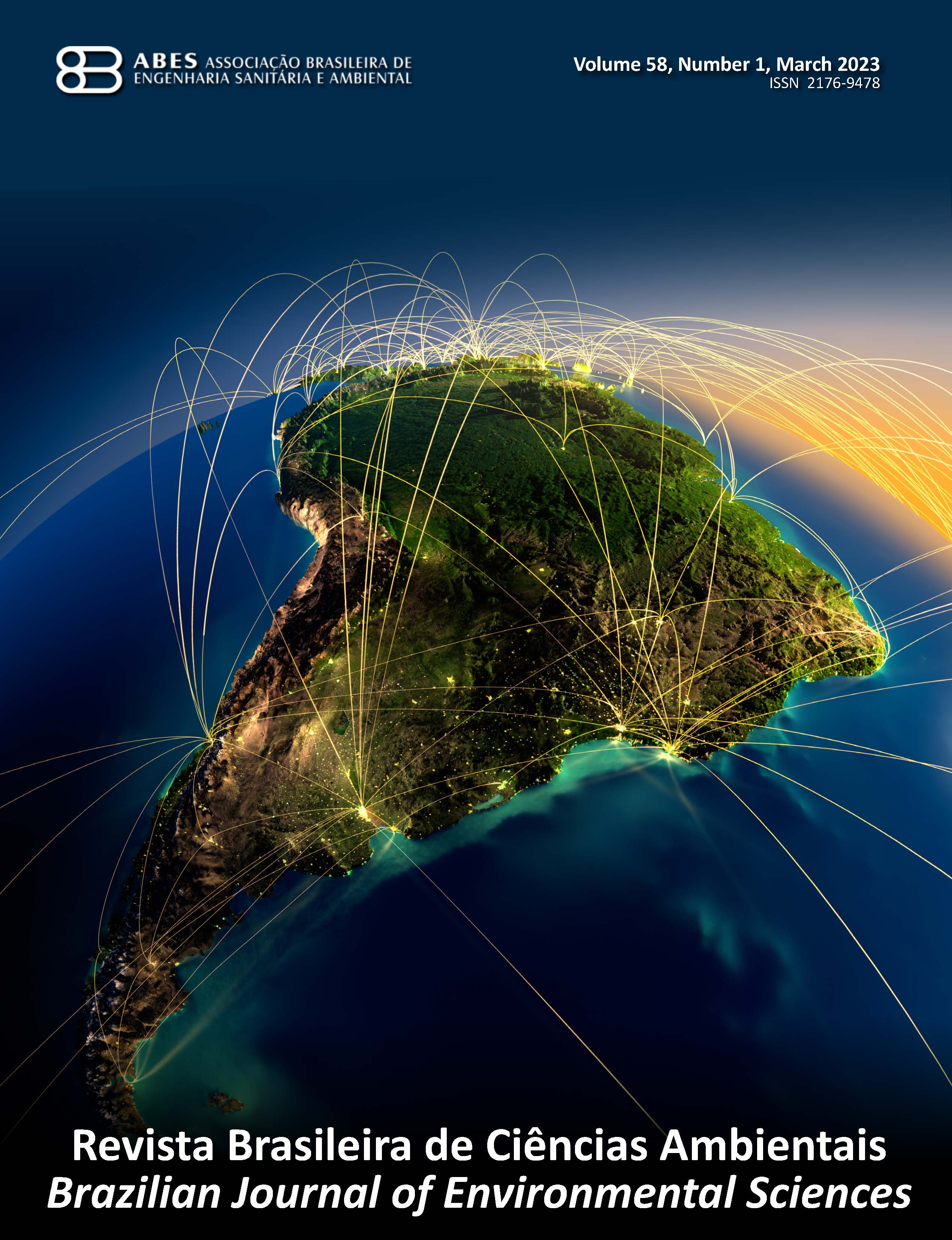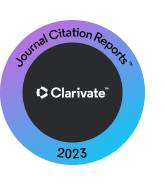Application of response surface methodology in the optimization of the clarification and filtration system for the treatment of water from Açude Grande (PB), Brazil
DOI:
https://doi.org/10.5327/Z2176-94782411Abstract
The deterioration of the environmental quality of the Açude Grande waters has worsened the water availability in the city of Cajazeiras (Paraíba state, Brazil) during drought periods. Thus, this study aimed to evaluate clarification followed by filtration to treat Açude Grande water. The research is innovative in applying optimization methods to conventional techniques for treating water sources considered unsuitable for human consumption in areas with limited water resources and economic and operational constraints. Thereby, the variables of aluminum sulfate concentration and pH were optimized based on the removal of turbidity and apparent color during the clarification stage (coagulation, flocculation, and decantation) using the central composite rotational design factorial plan associated with the response surface methodology. Subsequently, the filtration stage, consisting of a sand and gravel layer, was simulated at bench scale. The results showed that a coagulant dose of 60.0 mg.L-1 and a pH of 6 achieved the best removal of turbidity (67.3%) and apparent color (78.1%), bringing the turbidity parameter within the limits of the Ministry of Health Ordinance GM/MS No. 888/2021. As for the filtration process, it showed good efficiency in removing turbidity (>77.0%), apparent color (>70.0%), and biochemical oxygen demand (>46.0%) compared to the post-clarification sample. It is concluded that conventional treatment can potentially adjust the investigated parameters to organoleptic potability standards, with pre-oxidation being suggested to enhance the removal of organic matter.
Downloads
References
American Public Health Association (APHA); American Water Works Association (AWWA); Water Environment Federation (WEF), 1992. Standard Methods for the Examination of Water and Wastewater. 18th ed. APHA, Washington, D.C.
American Public Health Association (APHA); American Water Works Association (AWWA); Water Environment Federation (WEF), 2017. Standard Methods for the Examination of Water and Wastewater. 23th ed. APHA, Washington, D.C.
Amiri, A.; Sabour, M.R., 2014. Multi-response optimization of Fenton process for applicability assessment in landfill leachate treatment. Waste Management, v. 34 (12), 2528-2536. https://doi.org/10.1016/j.wasman.2014.08.010.
Azzam, M.I.; Korayem, A.S.; Othman, S.A.; Mohammed, F.A., 2022. Assessment of some drinking water plants efficiency at El-Menofeya Governorate, Egypt. Environmental Nanotechnology, Monitoring & Management, v. 18, 100705. https://doi.org/10.1016/j.enmm.2022.100705.
Benakcha, M.; Masmoudi, T., 2024. Effect of adding biochar from prickly pear skin to aluminium sulphate to improve the coagulation-flocculation process during the elimination of humic substances present in the Laghrous drainage canal Water, Zab El-gharbi region (SE Algeria). Desalination and Water Treatment, v. 317, 100141. https://doi.org/10.1016/j.dwt.2024.100141.
Brasil, 2021. Ministério da Saúde – MS. Portaria n. 888, de 4 de maio de 2021. Diário Oficial da União, Brasília.
Brasil, 2023. Sistema Nacional de Informações sobre Saneamento. Diagnóstico temático serviços de água e esgoto: visão geral (Accessed March 25, 2024) at:. https://www.gov.br/cidades/pt-br/acesso-a-informacao/acoes-e-programas/saneamento/snis/produtos-do-snis/diagnosticos/DIAGNOSTICO_TEMATICO_VISAO_GERAL_AE_SNIS_2023.pdf.
Cañizares, P.; Jiménez, C.; Martínez, F.; Rodrigo, M.A.; Sáez, C., 2009. The pH as a key parameter in the choice between coagulation and electrocoagulation for the treatment of wastewaters. Journal of Hazardous Materials, v. 163 (1), 158-164. https://doi.org/10.1016/j.jhazmat.2008.06.073.
Chiavola, A.; Di Marcantonio, C.; D’Agostini, M.; Leoni, S.; Lazzazzara, M., 2023. A combined experimental-modeling approach for turbidity removal optimization in a coagulation flocculation unit of a drinking water treatment plant. Journal of Process Control, v. 130, 103068. https://doi.org/10.1016/j.jprocont.2023.103068.
El-Taweel, R.M.; Mohamed, N.; Alrefaey, K.A. Husien, S.; Abdel-Aziz, A.B.; Salim, A. I. Mostafa, N.G.; Said, L.A. Fahim, I.S.; Radwan, A.G., 2023. A review of coagulation explaining its definition, mechanism, coagulant types, and optimization models; RSM, and ANN. Current Research in Green and Sustainable Chemistry, v. 6, 100358. https://doi.org/10.1016/j.crgsc.2023.100358.
Ferreira Filho, S.S., 2017. Tratamento de água: concepção, projeto e operação de estações de tratamento. GEN/LTC, Rio de Janeiro, 463 p.
Fleyfel, L.M.; Matta, J.; Sayegh, N.F.; El Najjar, N.H., 2024. Olive mill wastewater treatment using coagulation/flocculation and filtration processes. Heliyon, v. 10 (22), e40348. https://doi.org/10.1016/j.heliyon.2024.e40348.
Husen, A.K.; Bidira, F.; Desta, W.H.; Asaithambi, P., 2024. COD, color, and turbidity reduction from surface water using natural coagulants: Investigation and optimization. Progress in Engineering Science, v. 1 (2-3), 100007. https://doi.org/10.1016/j.pes.2024.100007.
Kisakye, V., 2023. A bucket sand filter and Moringa Oleifera drinking water treatment hybrid system for rural households. Scientific African, v. 20, e01689. https://doi.org/10.1016/j.sciaf.2023.e01689.
Kolling Neto, A.; Ribeiro, R.B; Fraga, M.S.; Pruski, F.F., 2024. Estimating water balance in a Brazilian semiarid watershed using different spatial data. Journal of South American Earth Sciences, v. 140, 104930. https://doi.org/10.1016/j.jsames.2024.104930.
Myers, R.H.; Montgomery, D.C.; Anderson-Cook, C.M., 2016. Response Surface Methodology: Process and Product Optimization Using Designed Experiments. 4th ed. Wiley, Hoboken, New Jersey, 856 p.
Rachid, E.B.; Abderrahim, S.; Hafid, A.; Souad, R., 2024. Water treatment: aluminum sulfate, polymer, and activated carbon between efficacy and overdosing. Case of Oum Er-Rbia River, Morocco. Desalination and Water Treatment, v. 317, 100273. https://doi.org/10.1016/j.dwt.2024.100273.
Rodrigues, M.I.; Iemma, A.F., 2014. Planejamento de Experimentos e Otimização de Processos. 3th ed. Cárita Editora, Campinas, 358p.
Romphophak, P.; Chamnanmor, R.; Fagkaew, P.; Sairiam, S.; Painmanakul, P., 2024. Modelling the predictive analysis of turbidity removal efficiency in the in-line coagulation and flocculation process. Chemical Engineering Research and Design, v. 210, 301-310. https://doi.org/10.1016/j.cherd.2024.08.028.
Sabogal-Paz, L.C.; Campos, L.C.; Bogush, A.; Canales, M., 2020. Household slow sand filters in intermittent and continuous flows to treat water containing low mineral ion concentrations and Bisphenol A. Science of The Total Environment, v. 702, 135078. https://doi.org/10.1016/j.scitotenv.2019.135078.
Shah, A.; Arjunan, A.; Manning, G.; Batool, M.; Zakharova, J.; Hawkins, A.J.; Ajani, F.; Androulaki, I.; Thumma, A., 2024. Sequential novel use of Moringa oleifera Lam., biochar, and sand to remove turbidity, E. coli, and heavy metals from drinking water. Cleaner Water, v. 2, 100050. https://doi.org/10.1016/j.clwat.2024.100050.
Sória, M.; Tavares, V.E.Q.; Pinto, M.A.B.; Stumf, L.; Zarnott, D.; Bubolz, J.; Norenberg, B.G., 2020. Evaluation of physicochemical waterparameters in watersheds of southern Brazil. Revista Ambiente & Água, v. 15 (5), e2596. https://doi.org/10.4136/ambi-agua.2596.
Trinh, T.K.; Kang, L.S., 2011. Response surface methodological approach to optimize the coagulation–flocculation process in drinking water treatment. Chemical Engineering Research and Design, v. 89 (7), 1126-1135. https://doi.org/10.1016/j.cherd.2010.12.004.
Xiao, D.; Nan, J.; Zhang, X.; He, W.; Fan, Y.; Lin, X., 2024. Pilot-scale study of turbid particle evolutional/removal characteristics during coagulation-sedimentation-filtration (CSF): Effects of coagulant dosage and secondary dosing after breakage. Journal of Water Process Engineering, v. 68, 106325. https://doi.org/10.1016/j.jwpe.2024.106325.
Downloads
Published
How to Cite
Issue
Section
License
Copyright (c) 2025 Revista Brasileira de Ciências Ambientais

This work is licensed under a Creative Commons Attribution 4.0 International License.

























